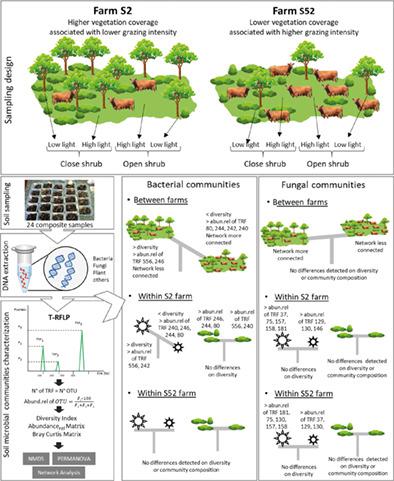当前位置:
X-MOL 学术
›
Ann. Appl. Biol.
›
论文详情
Our official English website, www.x-mol.net, welcomes your
feedback! (Note: you will need to create a separate account there.)
Assessing soil microbial biodiversity as affected by grazing and woody vegetation cover in a temperate savannah
Annals of Applied Biology ( IF 2.2 ) Pub Date : 2021-04-07 , DOI: 10.1111/aab.12695 Veronica A. El Mujtar 1 , Viviana C. Gregorutti 2 , Roxana P. Eclesia 2 , Ana Wingeyer 2 , Lucreci Lezana 2 , Sonia B. Canavelli SB 2 , Pablo Tittonell 1
Annals of Applied Biology ( IF 2.2 ) Pub Date : 2021-04-07 , DOI: 10.1111/aab.12695 Veronica A. El Mujtar 1 , Viviana C. Gregorutti 2 , Roxana P. Eclesia 2 , Ana Wingeyer 2 , Lucreci Lezana 2 , Sonia B. Canavelli SB 2 , Pablo Tittonell 1
Affiliation

|
Although it is well established that land use and management affects soil microbial biodiversity, with consequences for soil-mediated ecosystem services, knowledge on human-induced variability in soil bacterial and fungal communities is more abundant for cropping than for livestock systems. In particular, grazing management affects vegetation cover and light availability to lower vegetation layers, particularly in wooded grazing ecosystems. Our objective was to evaluate the use of T-RFLP analysis to characterise soil microbial community patterns. We worked in a grazed temperate savannah in Entre Ríos (Argentina) and focused on two farms with different grazing management, resulting in different vegetation cover. At each farm, we sampled soils from four conditions forming a two shrub cover conditions (open and close) by two light availability conditions (high and low) factorial set with three replicates. T-RFLP data for bacteria and fungi were used to characterise biodiversity patterns (diversity indexes, relative abundance of operational taxonomic units and community structure). Analyses were performed, between and within farms, using nonmetric multidimensional scaling analysis, non-parametric multivariate analysis of variance and network analysis. Variation patterns of soil microbial communities were detected using T-RFLP analysis in savannah soils from these two livestock farms. Farm, light and shrub conditions were statistically significant factors shaping variation patterns. For bacterial communities, light availability and shrub cover affected biodiversity and community structure respectively, but this impact was detected only for the farm with lower grazing intensity. For fungal communities, light availability was the factor shaping community structure, also with slightly higher impact on the farm with lower grazing intensity. These results suggest that in temperate woodlands lower grazing intensity, associated with higher vegetation cover, increases bacterial biodiversity while it decreases fungal community structure. Soil bacterial and fungal communities, showed contrasting patterns, and appear as sensitive indicators to monitor grazing management effects. We showed that T-RFLP analysis is a cost-effective methodology (compared to Illumina sequencing) that would be useful to disentangle impact of grazing intensity and vegetation cover in grazed temperate savannah.
中文翻译:

评估温带大草原中受放牧和木本植被覆盖影响的土壤微生物多样性
尽管土地利用和管理会影响土壤微生物生物多样性,从而对土壤介导的生态系统服务产生影响,但关于人类引起的土壤细菌和真菌群落变异的知识对于种植而言比畜牧系统更为丰富。特别是,放牧管理会影响植被覆盖度和较低植被层的光照,尤其是在树木繁茂的放牧生态系统中。我们的目标是评估使用 T-RFLP 分析来表征土壤微生物群落模式。我们在 Entre Ríos(阿根廷)的温带大草原上工作,专注于两个不同放牧管理的农场,导致不同的植被覆盖。在每个农场,我们从四个条件采样土壤,形成两个灌木覆盖条件(开放和关闭),通过三个重复的两个光照可用性条件(高和低)因子集。细菌和真菌的 T-RFLP 数据用于表征生物多样性模式(多样性指数、操作分类单位的相对丰度和群落结构)。使用非度量多维尺度分析、非参数多变量方差分析和网络分析,在农场之间和农场内进行分析。使用 T-RFLP 分析在这两个养殖场的稀树草原土壤中检测土壤微生物群落的变化模式。农场、光照和灌木条件是影响变异模式的统计显着因素。对于细菌群落,光照和灌木覆盖分别影响生物多样性和群落结构,但仅在放牧强度较低的农场检测到这种影响。对于真菌群落,光照是影响群落结构的因素,对放牧强度较低的农场影响也稍大。这些结果表明,在温带林地,较低的放牧强度与较高的植被覆盖率相关,增加了细菌生物多样性,同时减少了真菌群落结构。土壤细菌和真菌群落显示出对比鲜明的模式,并作为监测放牧管理效果的敏感指标出现。
更新日期:2021-04-07
中文翻译:

评估温带大草原中受放牧和木本植被覆盖影响的土壤微生物多样性
尽管土地利用和管理会影响土壤微生物生物多样性,从而对土壤介导的生态系统服务产生影响,但关于人类引起的土壤细菌和真菌群落变异的知识对于种植而言比畜牧系统更为丰富。特别是,放牧管理会影响植被覆盖度和较低植被层的光照,尤其是在树木繁茂的放牧生态系统中。我们的目标是评估使用 T-RFLP 分析来表征土壤微生物群落模式。我们在 Entre Ríos(阿根廷)的温带大草原上工作,专注于两个不同放牧管理的农场,导致不同的植被覆盖。在每个农场,我们从四个条件采样土壤,形成两个灌木覆盖条件(开放和关闭),通过三个重复的两个光照可用性条件(高和低)因子集。细菌和真菌的 T-RFLP 数据用于表征生物多样性模式(多样性指数、操作分类单位的相对丰度和群落结构)。使用非度量多维尺度分析、非参数多变量方差分析和网络分析,在农场之间和农场内进行分析。使用 T-RFLP 分析在这两个养殖场的稀树草原土壤中检测土壤微生物群落的变化模式。农场、光照和灌木条件是影响变异模式的统计显着因素。对于细菌群落,光照和灌木覆盖分别影响生物多样性和群落结构,但仅在放牧强度较低的农场检测到这种影响。对于真菌群落,光照是影响群落结构的因素,对放牧强度较低的农场影响也稍大。这些结果表明,在温带林地,较低的放牧强度与较高的植被覆盖率相关,增加了细菌生物多样性,同时减少了真菌群落结构。土壤细菌和真菌群落显示出对比鲜明的模式,并作为监测放牧管理效果的敏感指标出现。









































 京公网安备 11010802027423号
京公网安备 11010802027423号